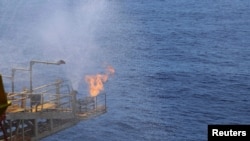Academics are warning the South China Sea could face worsening environmental degradation over the next two decades because the countries that claim it are focused on competing over maritime sovereignty instead of working together on relief measures.
Researchers have found oil leaks from commercial ships, and over-fishing and coral degradation from the construction of artificial islands threaten to change the ecology of the 3.5 million-square-kilometer sea.
China and the 10-member Association of Southeast Asian Nations (ASEAN), which includes five countries with maritime territorial claims in the sea, have a chance to incorporate environmental relief into a maritime code of conduct now after establishing a framework for it in August, some analysts believe.
“Whatever they are going to discuss, they must include environmental issues as a very important part of a code of conduct to provide guidance for the activities of coastal states,” said Liu Nengye, a University of Adelaide senior lecturer with a focus on the law of the sea. “No matter whether there is a dispute or not, they must be dealt with.”
Disputes hamper cooperation
Six countries dispute sovereignty over the sea that runs from Taiwan southwest to Singapore. Their differences have stood in the way of an agreement to stop degradation or repair damage, analysts say.
Disputes over rights have scuttled, for example, any chance of forming a multi-party agency that regulates fishing. As an example of what could happen, Arctic Ocean border states Norway and Russia have run a joint fisheries commission for 40 years, since the Soviet era. This year the two sides agreed to quotas per fish species.
“The more opportunities you have to engage in cooperation and the more institutions that you have that provide opportunities for interaction, the higher the prospects are that you can reach some kind of agreement over shared resources and how to manage them sustainably,” said Scott Moore, a water resource specialist with the World Bank Group Water Global Practice.
The South China Sea, he said is “certainly right up there in the top I would say three or four fisheries in the world for being exploited.”
China and Taiwan claim almost the whole sea. Brunei, Malaysia, Vietnam, Indonesia and the Philippines claim parts, pitting them against China as the most aggressive claimant. The four Southeast Asian countries have grown leerier of China since 2010 as the giant country steps up land reclamation, some for military installations.
Environmental issues are inevitable
Pollution is hard to avoid in the South China Sea because it supports one third to half of the world’s marine shipping traffic, which transports an estimated $5.3 trillion worth of goods per year.
Between 333,000 and 1.6 million vessels also fish the sea, said Zhang Hongzhou, research fellow with the China Program at the S. Rajaratnam School of International Studies at Nanyang Technological University in Singapore. About 3 million people depend on fishing in the sea for income.
Land reclamation for artificial islands also has been found to destroy coral reefs. A world arbitration court said in July of last year China’s construction at seven Spratly Island features in the sea had particularly harmed coral.
China had reclaimed about 3,200 acres (1,294 hectares) as of last year and Vietnam has used landfill to build up 27 features, according to the Asia Maritime Transparency Initiative under U.S. think tank The Center for Strategic and International Studies.
The hardest hit marine species are larger ones, including birds and mammals, Moore said. Tuna is particularly strained, experts say. Migratory species will struggle the most as they're not used to the tough environment.
Millions of tons of fish and 20 to 50 percent of revenues have been lost in the South China Sea, the conservation group World Wildlife Fund said in 2015. Demand for fish and at least the technical level of fishing, if not actual boats, could easily grow through 2045, a University of British Columbia study found in 2015.
Can rival claimants take action?
Without intervention, by 2045 fish common in the sea will decline 9 to 59 percent due to over-fishing, acidification of the water and carbon dioxide emissions, the study said.
“The national governments of countries in the South China Sea need to work, both individually and collectively with the international community, to immediately and substantially reduce CO2 emissions,” it said.
A code of conduct could “provide guidance” on managing fisheries and stopping pollution from ships and offshore fossil fuel exploration, Liu suggested in a paper published Sept. 8 on the Asia & The Pacific Policy Society website.
But turning calls from China and Southeast Asia for “joint development” are hard to turn into action, Zhang said.
“Let’s say even if they want to have some kind of fishery cooperation, it would be quite difficult for each party to agree on a set of rules,” Zhang said. “Even if you want to implement joint development, you have to agree on where to jointly develop.”








